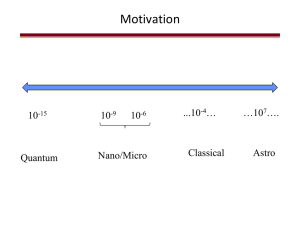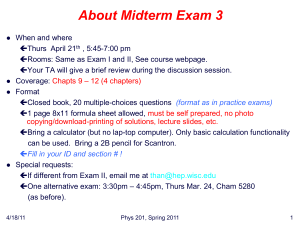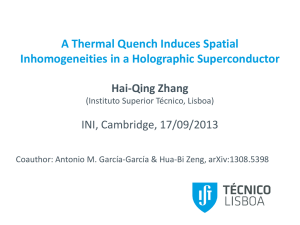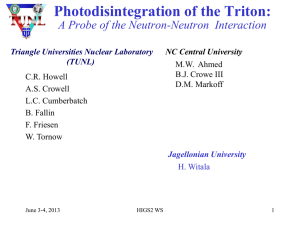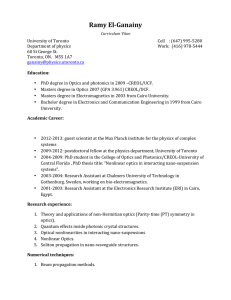PT-symmetric
advertisement
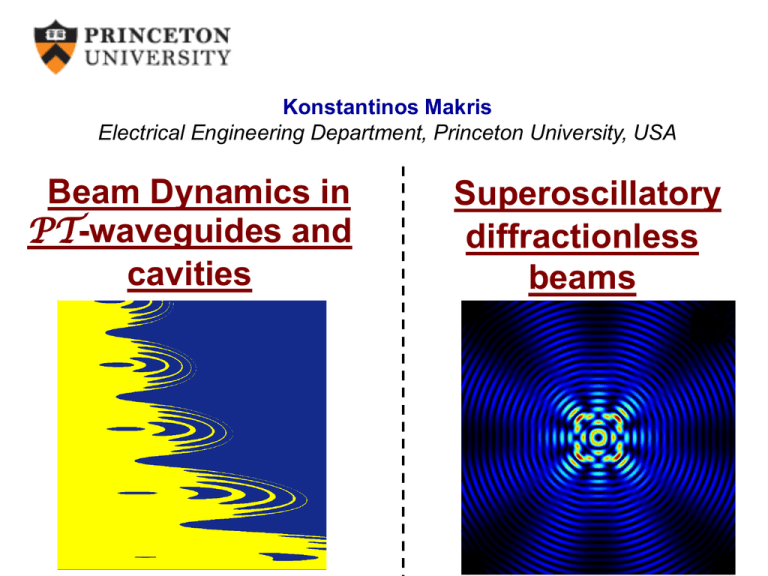
Konstantinos Makris Electrical Engineering Department, Princeton University, USA Beam Dynamics in PT-waveguides and cavities Superoscillatory diffractionless beams Collaborative groups R. El-Ganainy, and D.N.Christodoulides College of Optics /CREOL, University of Central Florida, USA M. Segev Technion, Israel P. Ambichl, and S. Rotter Institute of Theoretical Physics, TU-Wien, Vienna, Austria Z. Musslimani Mathematics department, Florida State University, USA •G. Aqiang and G. Salamo – University of Arkansas, USA •C. E. Rüter and D. Kip - Clausthal University, Germany Overview • Introduction to PT-symmetric Optics • Physical characteristics of PT-symmetric potentials • Group velocity in PT-symmetric lattices • PT-symmetry breaking in Fabry-Perot cavities • Conclusions Introduction to PT-symmetric Optics PT-symmetry in Quantum Mechanics Should a Hamiltonian be Hermitian in order to have real eigenvalues? Parity and Time operators pˆ pˆ Pˆ xˆ xˆ pˆ pˆ Tˆ xˆ xˆ i i PT-potential Schrödinger Equation 2 2 i V ( x) 2 t 2m x V * x V x PT symmetric Hamiltonian can exhibit entirely real eigenvalue spectrum! M.Bender et al, Phys. Rev. Lett., 80, 5243 (1998); C. M.Bender et al, Phys. Rev. Lett., 89, 270401 (2002) C. M.Bender et al, Phys. Rev. Lett., 98, 040403 (2007); C. M.Bender, Contemporary Physics, 46, 277 (2005) *C. Quantum mechanics and Wave Optics Paraxial Optics Quantum Mechanics z x Paraxial equation of diffraction E 1 2 E i k0 n ( x ) E 0 2 z 2k x Propagation constants Schrödinger equation 2 2 i V ( x) 2 t 2m x Energy eigenvalues PT symmetry in Optics* iU z U xx VR x iVI x U U U 0 Nonlinear Schrödinger Equation 2 V x V x * PT-symmetric potential Typical parameters X VR x VI x 0.5m 0 1.6m nRmax 103 g a 30cm1 G nImax 5 104 L *R. El-Ganainy, K.G.Makris, D. N. Christodoulides, and Z. H. Musslimani, Opt. Lett. 32, 2632 (2007). K. G. Makris, R. El-Ganainy, D. N. Christodoulides, and Z. H. Musslimani, Phys. Rev. Lett. 100, 103904 (2008). Z.H.Musslimani, K. G. Makris, R. El-Ganainy, D. N. Christodoulides, Phys. Rev. Lett. 100, 030402 (2008). K. G. Makris, R. El-Ganainy, D. N. Christodoulides, and Z. H. Musslimani, Phys. Rev. A 81, 063807 (2010). *R. El-Ganainy, K.G.Makris, and D. N. Christodoulides, Phys. Rev. A 86, 033813 (2012). Observation of PT-breaking in a passive coupler Observation of PT-breaking in an active coupler Experimental realization of PT-lattice Parity–time synthetic photonic lattices, A. Regensburger, C. Bersch, A. Miri, G. Onishchukov, D. N. Christodoulides , and U. Peschel Nature, 488, 167–171 (09 August 2012) Photonic crystals Negative index materials PT-symmetric Optics z PT-symmetric waveguides PT-symmetric cavities Physical characteristics of PT–potentials PT Phase transition in a single waveguide* V x sec h2 x iV0 sec h x tanh x Scarff potential Exceptional point V0 1.25, real eigenvalues V0 1.25, complex eigenvalues Abrupt phase transition * u m x un x dx dnnm 0 *Z. Ahmed, Phys. Lett. A, 282, 343 (2001) W.D. Heiss, Eur. Phys. J. D 7, 1 (1999) Biorthogonality condition Floquet-Bloch modes in real lattices* z n k , x exp i n k z Floquet Bloch mode Discrete Diffraction k : Bloch wavenumber, n : number of band D period * m k ', x n k , x dx n,m k k ' Orthonormality relation x H x Bandstructure D An k n k , x dk Superposition principle n 1 D An k n* k , x H x dx Projection coefficients H x dx 2 D n 1 D An k dk 2 Parseval’s identity D 10 m a 4.4 m 2.1103 *D. N. Christodoulides, F. Lederer, and Y. Silberberg, Nature, 424, 817 (2003). Bandstucture of a PT optical lattice* V x 4 cos 2 x iV0 sin 2 x V0 0.5 real eigenvalues If V0 0.5 complex eigenvalues If V0 0.5 Exceptional point Before phase transition n k n k n k, x n* k, x After phase transition *K. G. Makris, R. El-Ganainy, D. N. Christodoulides, and Z. H. Musslimani, Phys. Rev. Lett. 100, 103904 (2008). PT–symmetric optical cavities Scattering from Fabry-Perot PT cavities* g: gain/loss G L broken r t ' S g t r ' Scattering matrix S g S g I unbroken * P S g P S g Basic relations 0 1 P 1 0 P S † g P S * g 1, below PT threshold * 1, above PT threshold *L. Ge, Y. D. Chong, and A.D. Stone, Phys. Rev. Lett. 106, 093902 (2011). Exceptional point Motion of Scattering matrix eigenvalues in the complex plane Relation between finite and open PT-cavities* Helmholtz equation in finite domain (Cavity length)/2 zz z k02 0 z * z L L Gain-loss amplitude *P. Amblich, K.G.Makris, L. Ge, Y. D. Chong, and S. Rotter, to be submitted (2013). General Robin Boundary Conditions Finite and open PT-cavities Finite PT-system zz z k02 0 L L Open scattering PT-system aout ain ain S bout bin bin Each eigenstate of S is also an eigenstate of an effective Hamiltonian Heff with the appropriate Robin boundary conditions 1 i 1 1 The effective Hamiltonian Heff is PT-symmetric when The 2D union of all the eigenvalue curves of Heff for is identical to the unbroken phase of the open scattering problem Practical considerations for observing PT-scattering in cavities a G L Eigenvector of S-matrix aei Symmetric output power below EP Eigenvector of S-matrix n1 1.5 ig , n2 1.5 ig , L 5 m, 0 1 m broken Asymmetric output power above EP Physical value of gain at the exceptional point g 0.1 g phys 12000cm1 g 0.001 g phys 120cm1 g 0.0001 g phys 12cm1 broken Typical physical values n 1.5 ig , 0 1 m, L ~ 3mm g ~ 4 104 g phys ~ 48cm 1 We need long cavities to observe PT-phase transition g-mismatch 10% tolerance unbroken Effect of incidence angle in scattering in PT-cavities n1 1.5 ig , n2 1.5 ig , L 5 m, 0 1 m It is experimentally easier if the angle of incidence is non-zero unbroken TE polarization unbroken g PT 0.11 TM polarization Scattering coefficients in 2 layer PT-cavities* R r Reflectance from left to right 2 R' r' T t t' 2 2 Reflectance from left to right 2 Transmittance For ~ 19 both transmission resonance points are below the EP o Normal incidence R 0, T 1 L. Ge, Y. Chong, D. Stone, PRA 85, 023802 (2012) Multilayer Fabry-Perot PT-cavities* 12 layers, TE, normal incidence broken broken zoom Multiple phase transitions *K.G.Makris, P. Amblich, L. Ge, S. Rotter, and D. N. Christodoulides to be submitted (2013). Multilayer Fabry-Perot PT-cavities TM-polarization TE-polarization 12 layers broken broken EP1 Experimentally, we do not need to scan the length of cavity, but the angle EP2 Closed paths of scattering eigenvalues in complex plane TE, 0 Superoscillatory diffractionless beams K.G. Makris Electrical Engineering Department, Princeton University, USA E. Greenfield, and M. Segev Physics Department, Solid State Institute, Technion, Israel D. Papazoglou, and S. Tzortzakis Materials Science and Technology Department, University of Crete, Heraklion, Greece Institute of Electronic Structures and Laser, Foundation for Research and Technology Hellas, Heraklion, Greece D. Psaltis School of Engineering, Swiss Federal Institute of Technology Lausanne (EPFL), Switzerland Optical Superoscillations Superoscillatory field: A field that locally has subwavelength features but no evanescent waves. Theoretical suggestion: Optical super-resolution with no evanescent waves M. V. Berry, and S. Popescu, J. Phys. A: Math. Gen. 39, 6965 (2006) M. V. Berry, and M. R. Dennis, J. Phys. A: Math. Theor. 42, 022003 (2009) P. J. S. G. Ferreira and A. Kempf, IEEE Trans. Signal Process., 54, 3732, (2006) M. R. Dennis, A. C. Hamilton, and J. Courtial, Opt. Lett. 33, 2976 (2008) Optical Experiment: Subwavelength focus in the far field with no evanescent waves N. I. Zheludev, Nature 7, 420 (2008); F. M. Huang, et al., J. Opt. A: Pure Appl. Opt. 9, S285 (2007); F. M. Huang, and N. I. Zheludev, Nano Lett. 9, 1249 (2009) Fabrication of Superoscillatory lens E. T. F. Rogers, et al. Nature Materials 11, 432 (2012). Diffraction-free beams in Optics* 2U 2U 2U 2 k 0U 0 2 2 2 z x y U x, y, z J m ar eim ei z r x 2 y 2 , tan y / x Helmholtz equation Bessel beam of mth order k0 2 m=0 •They are stationary solutions of Helmholtz equation •They have no-evanescent wave components (band-limited) •They carry infinite power, thus they do not diffract 2 kx2 k y2 k02 0 a k0 where a2 k2 kx2 k y2 1 m 0 a 2 m 1 no evanescent waves The lobes of a Bessel beam are always of the order of Question: Can we have diffractionless beams with sub- features? Answer: YES, by using the concept of superoscillations m=3 *J. Durnin, J. Opt. Soc. Am. A 4, 651 (1987), J. Durnin, J. J. Miceli, and J. H. Eberly, Phys. Rev. Lett. 58, 1499 (1987). m=3 Intensity profiles of Bessel beams Stationary Superoscillatory beams* U x, y, z f x, y exp i z Pm xm , ym , m 1,..., N We force the field to pass through N predetermined points in the x-y plane N f x, y cm f m1 x, y The field as superposition of solutions of Helmholtz equation m 1 Solution of the problem c M 1 f If the distances between the Pm points are subwavelength, the coefficients cm will give us a superoscillatory superposition K. G. Makris and D. Psaltis, Opt. Lett. 36, 4335 (2011). Stationary solution of Helmholtz equation f 0 r1 f1 r1 ... f N 1 r1 f 0 r2 f1 r2 ... f N 1 r2 M ... ... ... ... f 0 rN f1 rN ... f N 1 rN N N c [c1 c2 ...cN ]T rn xn , yn f [ f r1 f r2 ... f rN ]T Analytical form of a superoscillatory beam* We choose to write our field as superposition of Bessel beams Jn r1,1 , , r2 ,2 0,0 , r3 ,3 ,0 3 f x, y cm J m1 ar e i m 1 m 1 Polar coordinates Superposition of Bessel beams n 1 g1 1 g 2 1 M 1 g1 2 g 2 2 where 1 g1 3 g 2 3 f c [0 1 0]T [1 0 8 a ] 2 T gn m rm eim 1 n 1 , n 1, 2, m 1, 2,3 2 c1 f r2 1 c2 f r3 f r1 a c3 4 f r1 f r3 2 f r2 a 2 Specific example 2 U r, , z J 0 ar 8 a J 2 ar ei 2 ei z K. G. Makris and D. Psaltis, Opt. Lett. 36, 4335 (2011). Superoscillatory diffractionless beam Different 1D and 2D patterns Example 1: Superposition of J0,J1,J2 beams 1 m, a 2m1 zoom rI max U w FWHM 2 so _ region w FWHM ~ 400nm 3-point pattern I max rI ~ 1 70 subwavelength Example 2: Superposition of J2,J6,J10 beams Phase singularities on sub-wavelength scale 1 m rI ~ 1 300 w ~ 300nm subwavelength 12-point pattern a 2 m1 Experimental set-up* E1 A21ei m kz J 2 (ar ) i m kz E A e J 2 (a r r ') 2 22 Diffraction limit: /(2 NA) 19 m Wavelength: 633nm Superposition of two spatially translated J2 Bessel beams Superpostion and not an interference effect *E. Greenfield, R. Schley, H. Hurwitz, J. Nemirovsky, K.G. Makris, and M. Segev, Optics Express, accepted (2013) Observation of superoscillatory beams w=2.5 m~4 rI 1 100 w Conclusions PT-symmetry in optical periodic potentials Group velocity in PT-lattices PT- symmetric scattering in cavities Relation between PT open and finite systems Diffractionless superoscillatory beams Observation of stationary superoscillatory beams

